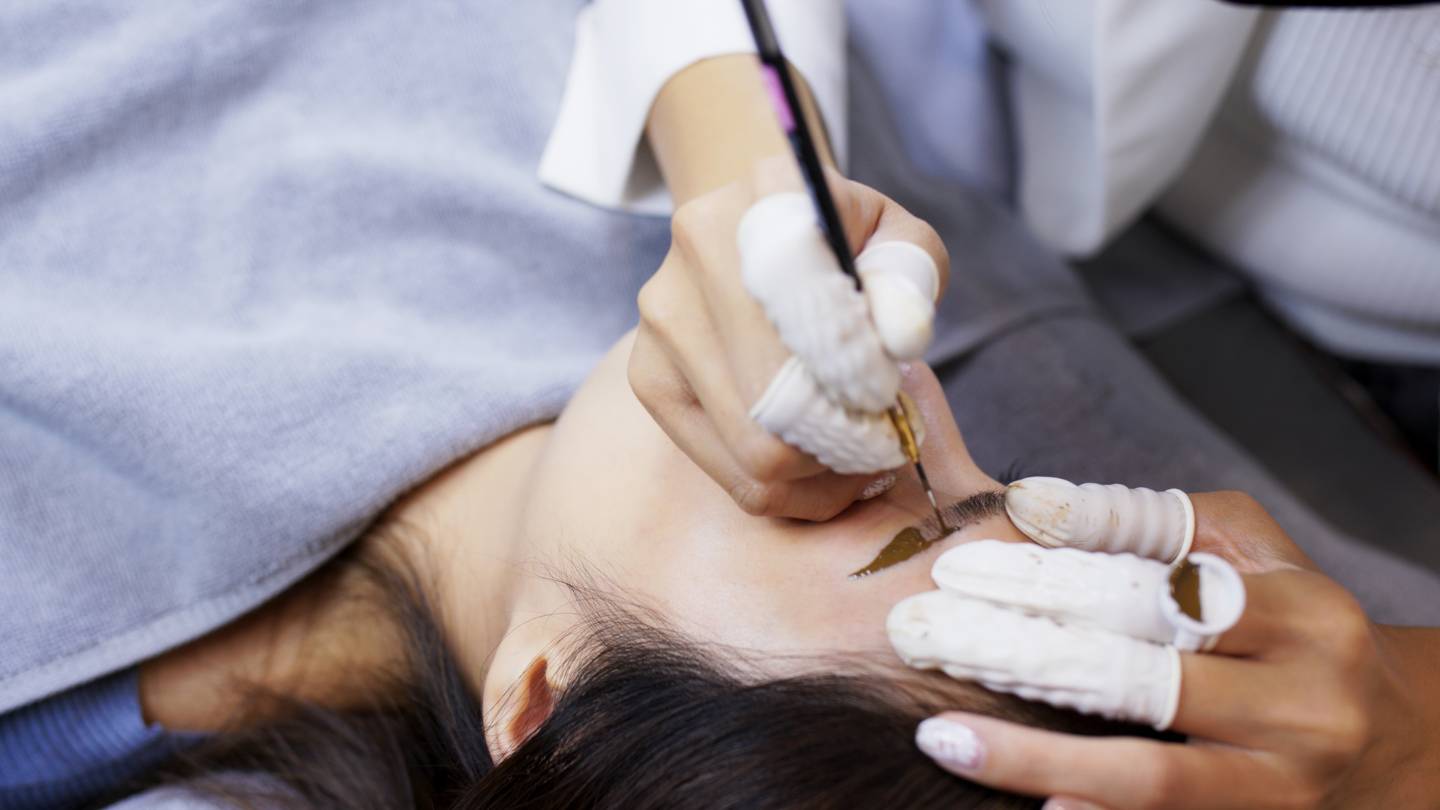Microblading has gained popularity for promising long-lasting, natural-looking eyebrows. It’s a semi-permanent cosmetic procedure involving fine strokes to mimic natural hair.
While the results can be stunning, many wonder how to avoid a microblading disaster. Making an informed decision and avoiding common mistakes is essential to ensure the best results.
This guide will cover everything you need to know, from choosing a qualified technician to understanding the potential dangers of the procedure.
Let’s get straight to the point.
To avoid a microblading disaster, choose a highly trained and certified artist with positive reviews and a clean, safe work environment. Ensure proper preparation, including cleaning and sanitising the workspace, and communicate clearly about the desired brow shape and colour.
Key mistakes to avoid include using incorrect blade angles, applying the wrong amount of pigment, and neglecting aftercare instructions. Don’t select an artist based solely on price; always request before-and-after photos.
Trust your instincts—if you feel uneasy with the artist, don’t proceed.
Tips For Avoiding Microblading Mistakes
1. Preparation Is Key
One of the most common mistakes when using a microblading kit is inadequate preparation. Before the procedure, the space should be thoroughly cleaned and sanitised to reduce the risk of infection.
Gather all the necessary tools and materials beforehand. Clear communication with the client is also essential.
Discuss their expectations, including eyebrow shape, colour, and thickness. Miscommunication can lead to disappointing results, so ensure both parties are on the same page.
2. Correct Blade Angle
The success of microblading largely depends on the angle at which the blade is held. Holding the blade incorrectly can result in uneven or unnatural-looking eyebrows.
Maintaining a consistent angle throughout the procedure ensures symmetrical and well-defined brows.For beginners, practising the correct blade angle on practice pads or imitation skin is highly recommended.
This will help build muscle memory and improve technique before working on real clients.
3. Proper Pigment Application
Another common mistake is incorrect pigment application. Applying the pigment too lightly can cause the brows to fade quickly, while applying it too heavily can make them look harsh or unnatural.
The key is gradually building and layering the pigment to achieve the desired shade. When choosing a pigment, consider the client’s skin tone and natural hair colour.
This will ensure a natural-looking result that complements the client’s features.
4. Follow Aftercare Instructions
Proper aftercare is important for achieving long-lasting results. Failing to follow aftercare guidelines can lead to infections, faster fading, or scarring.
Advise your client to avoid getting their eyebrows wet, avoid using harsh skincare products, and resist the urge to pick or scratch the treated area.
Understanding Microblading Risks
Microblading is not without risks, much like any cosmetic procedure. The most common risks associated with microblading include:
- Infection: Tiny skin punctures made during the procedure can cause infection. To minimise the risk, it’s important to follow proper aftercare instructions.
- Allergic Reactions: Some people may have allergic reactions to the pigments used in microblading. If you have sensitive skin, always test for allergies beforehand.
- Unwanted Results: The goal of microblading is a natural appearance, but sometimes, the outcome may need to meet expectations. This could include unnatural colour, incorrect shape, or uneven strokes.
- Fading: Since microblading is semi-permanent, the pigment will gradually fade. Touch-ups are necessary to maintain the desired look.
Top Reasons Why Microblading Fails
Even with the best intentions, microblading can go wrong. Here are the top six reasons for microblading failures:
1. Untrained Technician
Working with an untrained or underqualified technician is one of the most significant causes of microblading disasters. Microblading requires high skill and precision; not all technicians have received the necessary training.
Always ask for proof of certification and training from a reputable institution.
2. No Outline Drawn Beforehand
Regardless of how experienced a technician may be, outlining the brows before starting the procedure is essential. Without an outline, there’s a risk of miscommunication between the client and the technician, which could lead to unsatisfactory results.
The outline helps both parties visualise the final look and make necessary adjustments.
3. False Promises About Brow Size
Some microblading artists may assure clients that the brow shape will shrink after the procedure. However, the size and shape of the brows should remain consistent with the drawn outline.
Adjustments should be made before treatment if the outline appears too large or dramatic.
4. Choosing An Artist Based On Price Alone
While choosing a microblading artist based solely on price is tempting, this can lead to disastrous results. Low prices often indicate inexperience or a lack of proper training.
Skilled artists charge higher fees due to their experience, training, and the quality of their work. Opting for a cheaper option could result in brows that require costly corrective procedures later.
5. No Before-And-After Photos
Before committing to a microblading artist, ask to see before-and-after photos of their previous work. This will give you a better idea of their skill level and the quality of their results.
If an artist cannot or unwillingly provide examples of their work, it’s best to look elsewhere.
6. Feeling Uncomfortable With The Artist
Trust your instincts when meeting a microblading artist for the first time. If something feels off—whether it’s their attitude, hygiene practices, or the studio environment—it’s okay to walk away.
A successful microblading experience requires trust and clear communication between the client and the artist.
Choosing The Right Microblading Aesthetician
When selecting a microblading aesthetician, there are several factors to consider:
1. Experience And Certification
The aesthetician should have extensive experience and certification from a reputable institution. Microblading is a skill that requires years of practice to perfect.
Be sure to check their credentials and look for evidence of ongoing education in the field.
2. Reviews And Testimonials
Look for online reviews or ask for referrals from previous clients. Satisfied customers are the best indicator of an artist’s reliability and skill.
Pay close attention to reviews that mention the initial results and the healed outcome, as this will give you an idea of how the brows will look over time.
3. Cleanliness And Safety
Hygiene is critical in any cosmetic procedure, and microblading is no exception. The aesthetician should use sterile, single-use tools and follow strict sanitation protocols.
A clean and safe environment reduces the risk of infection and ensures the best possible results.
4. Consultation
A thorough consultation before the procedure is essential. This is the time to discuss your desired brow shape, fullness, and colour.
A skilled technician will take the time to understand your goals and advise you on the best approach.
Conclusion
When done correctly, microblading can provide long-lasting, natural-looking results. However, avoiding common mistakes is crucial to ensuring the best outcome.
Proper preparation, blade angle, pigment application, and aftercare contribute to the procedure’s success. Additionally, choosing a skilled and experienced microblading artist is essential.
Look for certification, reviews, and examples of their work before committing. Investing in quality work upfront is better than dealing with corrective procedures later.
Following these guidelines can help you avoid a microblading disaster and enjoy the beautiful, confident brows you’ve always wanted.
FAQs About Microblading
Is There A Risk Of Infection With Microblading?
Yes, if proper hygiene measures are not followed. Ensure the artist uses sterile tools, wears disposable gloves, and maintains a clean working environment.
How Long Does Microblading Last, And Can Mistakes Be Corrected?
Microblading typically lasts 1-2 years. Mistakes can be corrected through touch-ups, but choosing an experienced artist is crucial to minimise errors from the start.
What Are Some Common Microblading Mistakes To Watch Out For?
Common mistakes include uneven eyebrows, incorrect colour choice, pigment fading unevenly, and scarring. A skilled artist can address and correct these issues during touch-up sessions.
How Long Should I Wait Between The Initial Microblading Session And A Touch-Up?
Waiting 4-6 weeks for the skin to heal is recommended before scheduling a touch-up session. This allows the artist to assess the healed results and make necessary adjustments.
What Aftercare Steps Can Help Prevent Microblading Complications?
Follow the artist’s aftercare instructions, including avoiding water exposure, sun exposure, and certain skincare products during the initial healing period.


